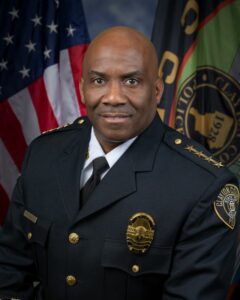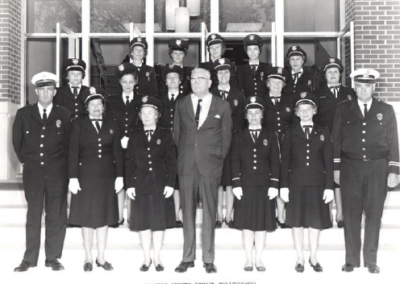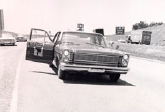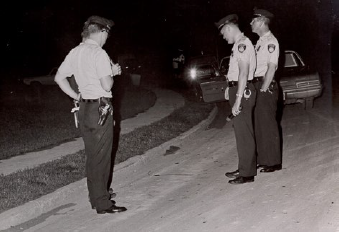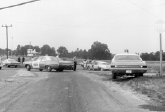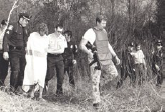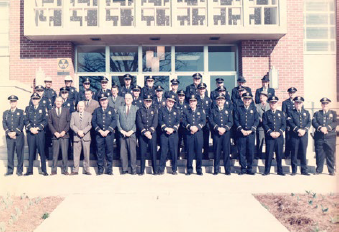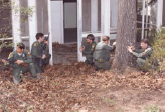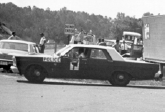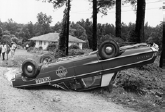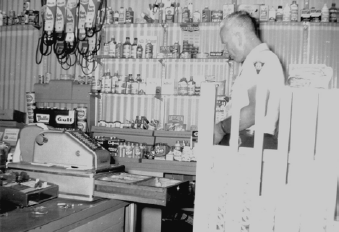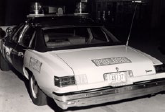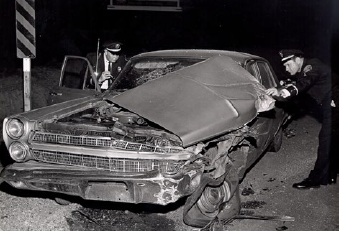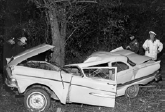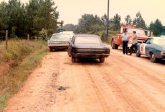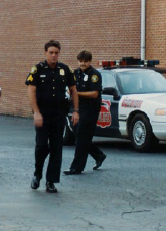History of the Department
History of the Department

1850s
Clayton County, Georgia’s 125th county, was formed on November 30, 1858.The first public officers were commissioned on January 13, 1859 with J.H.Waldrop being appointed Sheriff.
1860s
The first Clayton County Courthouse was built in 1861 at the intersection of Main Street and King Street in the city of Jonesboro.The 1861 courthouse was burned in 1864 during U.S.General Judson Kilpatrick’s raid on Jonesboro.The second county courthouse was built in 1869 upon the foundations of the 1861 courthouse and it still stands today as the hall of the Jonesboro Lodge No.87, Free and Accepted Masons.The first county jail was built in 1869 just east of the courthouse and it still stands at 125 King Street, Jonesboro.
1920s
During the earliest years of Clayton County’s development, the Office of the Sheriff was responsible for providing law enforcement services to the residents. State Legislation passed in 1914 (Chapter 23-14 County Police) authorized the County Commissioners or Ordinaries of any county having any number of population to elect or appoint county police at their discretion. As early as February 1927, the Clayton County Grand Jury recommended that the Commissioners of Clayton County create a county police force to assist the Sheriff. In December of 1928, Ernest Lamar Adamson was appointed Sheriff of Clayton County and hired W. Loy Dickson as his deputy. Together these two men enforced the laws of the State of Georgia as well as the ordinances of Clayton County. The county commissioners, although reluctant at first, due to the cost of paying salaries, agreed to hire two county policemen to work under the Sheriff ’s command. The first two county policemen were G.S.(Steve) Brown and J.O. “Buttermilk” Thompson. These officers wore blue uniforms to distinguish themselves from deputies who wore the traditional brown uniform and among other things were given the duty of inspecting roads and bridges to ensure their safety.
1930s
During Prohibition, Clayton County was a rural farm community plagued with the illegal manufacture of alcoholic beverages.Sheriff Adamson and Deputy Dickson along with county policemen Brown and Thompson were “efficient” lawmen according to the Grand Jury because throughout the 1930s they destroyed liquor stills, pursued “liquor cars” and arrested bootleggers on a daily basis.At every meeting of the Grand Jury, jurors recommended the addition of at least two more county policemen to assist Sheriff Adamson.The County Commission, although realizing the need for county police, was not prepared to raise taxes on their citizens to pay the additional $3,300 per year it would cost to hire two more policemen.Sheriff Adamson, despite his persistence, never got the additional county policemen he requested.On December 8, 1938, Sheriff Adamson left office and his wife Mrs.Ernest Lamar Adamson was appointed Sheriff to fill her husband’s unexpired term until a special election could be held.
On January 30, 1939, W.Loy Dickson was appointed Sheriff of Clayton County.Sheriff Dickson appointed Robert L.(Bob) Wynn as his deputy.The number of liquor stills appearing throughout the county overwhelmed both Sheriff Dickson and Deputy Wynn, and, again, the Grand Jury made numerous recommendations to the commissioners to hire more county policemen to assist the Sheriff.
1940s
- Chief of Police Robert L. (Bob) Wynn
April 1940 – December 1942
During a county commission meeting in April 1940, the commissioners agreed to hire two more county policemen and Deputy Robert L.(Bob) Wynn was appointed as the first Chief of County Police.Along with Chief Wynn and county policeman Howard Smith, the commissioners hired Mr.Jim Carr and Mr.W.S.Turner as policemen.These four men comprised the Clayton County Police Department of 1940.Back in those days, Clayton County was all farmland and sparsely populated mile after mile.Homes were scattered about the county, totaling 46.Officers worked six days a week, 12 hours per day and sometimes more.
In 1940, the Chief of Police was paid $125 per month plus $50 per month for car maintenance and expenses, and county policemen were paid $100 per month.During the first years of the County Police, the department depended on officers to provide their own vehicles for patrol cars.County policemen providing a car were given an additional $50 per month for vehicle expenses and maintenance.In December of 1942, Chief Wynn resigned, and the County Commission, in January 1943, opted not to appoint another chief, instead ordering that county policemen work under the Sheriff, again.
In April of 1943, the County Commission purchased the first county-owned police vehicle, a new 1942 Ford V-8 Super Deluxe Tudor (with 90 h.p.), for $1,142.On September 6, 1949, county policeman, Jim Carr, was appointed as the second Chief of Police.During that same month, the county purchased the first mobile transmitter and receiver radio from Radio Corporation of America (R.C.A.).With the appointment of Jim Carr, county policemen, again reported to the Chief of Police and worked under his command.
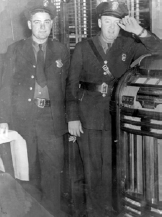
Howard Smith and Sam Blalock ca. 1940’s
1950s
- Chief of Police Howard Smith
January 1953 – April 1955
May 1958 – December 1978 - Chief of Police William W. (Billy) Clarke
April 1955 – May 1958
Although the details have been lost through the years, in the winter of 1956, Patrolman Eugene “Gene” Davis and Patrolman Wiggin Allen responded to a domestic dispute at a residence near what are now S.R. 138 and S.R. 85. The female involved in the altercation invited the officers into her home, reporting a dispute with her husband. As the patrolmen made their way to the back of the house, Patrolman Gene Davis walked past the husband who, unbeknownst to the patrolman, was waiting in a bathroom armed with a revolver. The husband shot Patrolman Davis in the chest during a time when bulletproof vests were not standard issue. Patrolman Davis was able to exit the house but was unable to call for help due to being shot in the lung. Once Patrolman Wiggin Allen realized the severity of incident, he carried Patrolman Davis to the hospital. A call was made to local police departments for assistance and it has been said that officers from the City of Atlanta, College Park and East Point arrived and surrounded the house. When the offender refused to exit the house, the officers fired several hundred rounds upon the house. It was later discovered that the offender had left the house and committed suicide in a barn prior to backup arriving. Patrolman Gene Davis survived his injuries and spent six months in recovery. He later went to work for the City of Albany Police Department where he retired. This was the first known shooting of a Clayton County officer in the line of duty.
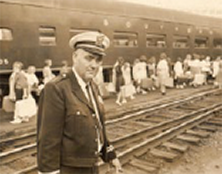
Chief Howard Smith ca. 1950’s
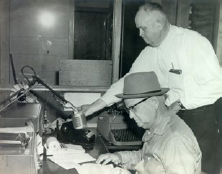
Henry Roberts and Ralph Smith in the Radio Room ca. 1950’s
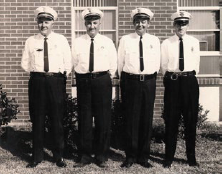
Chief Howard Smith, Frank Shockley, William Doster and James Parker
1960s
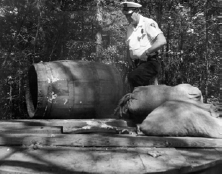
Investigating a liquor still in 1962
Clayton County enjoyed a low crime rate in the 1960s; however, traffic accidents were a burden on the small police force. As the department grew in size, the need for specialized training was realized. In 1962, six Clayton County police officers completed a very intense four-week training course offered by the Atlanta Police School that included traffic training among its 240 hours of instruction in general law enforcement. Instructors of the school praised the Clayton County class as “one of the best bunch of men ever to attend,” telling Chief of Police Howard Smith that the Clayton County officers performed exceptionally. Among the outstanding graduates were Leroy Smith and William Camp. Camp scored the second highest mark in the 13 years that the school had been in operation.
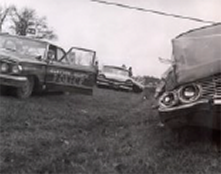
1964 Ford Galaxie
The Clayton County Grand Jury of the November 1964 Term felt that the county should build a headquarters building for the Police Department at the very earliest date possible since the police department was sharing a facility with the Sheriff ’s Office. They felt that the salaries of police should be raised to compare favorably with Atlanta and other areas and that the number of hours that officers worked be comparable to other police departments since at the time officers were working six days per week. The Grand Jury also felt that the county police should adopt a standard uniform with a name plate for officers to wear as many other departments had already done.
The county’s Civil Service system to protect employee rights was created in 1965.
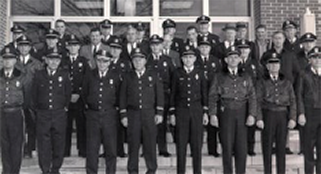
Clayton County Police Department ca. 1960’s
1970s
- Chief of Police C. Ronnie Thorton
December 1978 – April 1980
The county began installing traffic control lights in 1970 to help alleviate traffic crashes at busy intersections. It was during this same year that the police department appointed an officer to the newly formed Metro Atlanta Narcotics Squad. This was the foundation for the creation of the police department’s Narcotics Unit. In November 1970, the police department asked the FBI to draw up plans for a firing range to aid in firearms training. It was the first firing range in the state to be completed.
By May 1971, the police department had increased in size to 59 patrolmen, 54 policewomen (who were the modern day equivalent of school crossing guards), four dispatchers and three clerks. The department had 16 police cars, two motorcycles and a paddy wagon.
In April 1971, two Clayton County Patrolmen relinquished their weapons at gunpoint according to police reports. Det. Lt. J. F. Hughes and Lt. William Doster assisted the Sheriff ’s Office with presenting a warrant for William Sweat. Hughes and Doster located a man, later identified as Sweat, and asked him for his identification. Sweat responded by pulling a .38 caliber revolver out of his pants pocket, saying, “That’s my identification!” He forced the policemen to move back to their squad cars, took their guns and had them lie face down. Sweat fled the scene but, later, was apprehended after he telephoned the county police from a minister’s house and gave himself up.
Up until 1972, the police department utilized several different county facilities for police headquarters, often sharing space with the Sheriff ’s Office. During Chief Howard Smith’s second term, the county commission approved the construction of a new police headquarters complex. In 1972, the Clayton County Police Department headquarters was constructed at 7930 North McDonough Street adjacent to a Juvenile Detention Facility, which was built in 1964 on the corner of N. McDonough Street and S.R. 138. At the time of construction, the police headquarters was considered the most advanced facility in the southeastern United States.
During the 1970s, the department also created a North Precinct at 4231 Old Dixie Highway, Hapeville Georgia. Although it has not been used in decades, the original North Precinct still stands today just south of C. W. Grant Parkway.
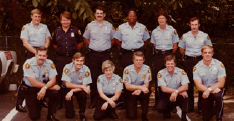
Officers assigned to the North Precinct on Old Dixie Highway in the 1970’s
During 1972, the police department hired its first African-American officer, Patrolman Sharkley J. Buford, and its first female officer, Brenda Mason. Mason was assigned to the plainclothes Detective Division. It wasn’t until 1974 that females were permitted to serve as uniformed officers. The first four female uniformed officers were Patrolman Toni Anderson (Tidwell), Patrolman Janice Greer, Patrolman Betty Thompson and Patrolman Pam Benefield.
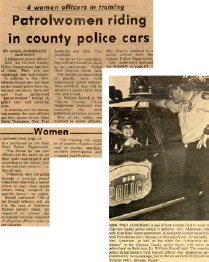
In December 1972, the police department requested the assistance of a helicopter from the Atlanta Police Department to aid in locating a 54-year-old woman who escaped from Clayton General Hospital. The woman was spotted by the helicopter in Senoia and subsequently picked up. This was the first time a helicopter had been used in this capacity, and it worked out well. During the 1970s, Captain Dave Johnson left the Atlanta Police Department and joined the Clayton County Police Department where he is credited with building the Aviation Unit from the ground up.
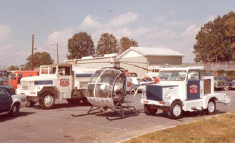
The Aviation Unit’s Schweizer 300C helicopter
A Crime Prevention Unit was established in 1973 consisting of only one man, Sergeant Robert Brown. By 1976, the unit had moved into its own space at the Flint River Village Shopping center located at Flint River Road and Kendrick Road. The unit’s function was to increase patrol efforts, conduct commercial and residential surveys, and oversee “Operation Identification,” which was an effort to mark property with electronic engravers to reduce instances of theft and aid in recovery of stolen property.
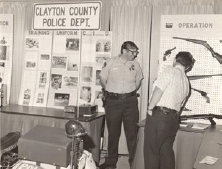
Patrolman Ron Evans representing the department at a community event ca. 1970’s
In 1973, the police department also created the Community Relations Unit, which was one of a few in existence at the time. The unit consisted of members of the Clayton County Police Department, the Clayton County Department of Family and Children’s Services, the Clayton County Juvenile Court, Clayton County Mental Health and the Clayton County Board of Education. The Community Relations Unit had its own a facility at Maddox Plaza. Among its purposes was the prevention of child abuse and other crisis intervention activities. The unit sponsored summer camps for children and worked with civic groups to provide Christmas parties and gifts to underprivileged children.
In 1974, several changes in the department were made after police department employees filed grievances with the county commissioners. A notable change was officers receiving department-issued revolvers, shotguns and ammunition instead of providing their own. Additionally, the Grand Jury recommended that walkie-talkies be placed in every patrol car and officers be allowed to use blue lights and sirens on the cars when responding to sick calls, persons shot, stabbed or otherwise seriously injured, or other related incidents. At the time, officers were allowed to run blue lights and sirens only when responding to a robbery in progress in a home or business.
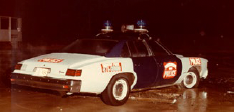
1977 Pontiac Lemans
The Clayton County Police Academy was first approved by the Georgia Peace Officer Standards and Training Council in December 1974 under the name of the Clayton County Regional Police Academy (CCRPA) with William Rowell of the Clayton County Police Department as the first Academy Director. The first class began on February 3, 1975 and was held in the Clayton County Civil Defense Building located at 7946 North McDonough Street, Jonesboro Georgia.
On May 6, 1975 at around 2 a.m., Clayton County Police Patrolman Ron Evans was shot in the abdomen after stopping a gold Cadillac with no license plate on Rex-Morrow Road. Patrolman Evans returned fire, striking the suspect five times. The suspect sped away. It was later learned that the vehicle had been reported stolen in Florida and the suspect had shot College Park Police officer Howard Belcher before shooting Officer Evans. The suspect, Herman Talmadge Gentry, was later charged with shooting both officers.
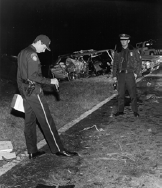
Officer Ring and Sergeant Jim Stone investigating an automobile accident in 1975
On October 21, 1978 at around 7 p.m, Patrolman William E. Putnam, Jr. investigated a vandalism call in the Camelot Subdivision where he spoke with the resident of 374 Lady Guinevere Way. The resident, Franklin Ball, barricaded himself in the home and then exchanged gunfire with Patrolman Putnam. Patrolman Putnam was grazed in the neck and chest. Franklin Ball was later talked into coming out of the house by the Clayton County SWAT Team and subsequently arrested.
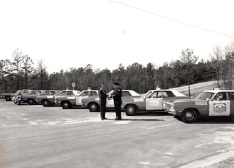
A fleet of new Plymouth Furys is delivered to the police department ca. 1970’s
1980s
- Chief of Police James D. Parker
April 1980 – September 1989 - Director of Public Safety Ronnie F. Clackum
March 1985 – September 1989 - Chief of Police Ronnie F. Clackum
September 1989 – August 2002
On June 4, 1980, Patrolman David Cannon and his partner Patrolman Steve Waits engaged in a motor vehicle pursuit of van occupied by robbery suspects wanted by the Sheriff ’s Office. After following the van from Highway 42 to I-285, the van exited at Bouldercrest Road where one of the suspects fired upon Patrolman Cannon’s patrol vehicle. Patrolman Cannon received bullet fragments to his chest; however, he continued to pursue the van. The van then abruptly stopped over a hillcrest and the occupants began firing a barrage of bullets, striking Patrolman Cannon’s windshield, which sent shards of glass into one of his eyes. The suspects were later taken into custody. Patrolman Cannon, unfortunately, lost his eye as a result of the injury.
On October 10, 1984 at around 11:30 p.m., Lowell Bridges shot Narcotics Agent Gary Ivey in the arm and leg after the Narcotics Unit attempted to execute a search warrant at 91 Conley Road. When no one answered the door at the residence, agents forced open the door. While checking the residence, Agent Ivey encountered Bridges in a bedroom where Bridges opened fire upon Agent Ivey six times from about four feet away, striking him twice. Bridges then attempted to shoot Agent Ivey in the back of the head but fortunately, the bullet only grazed his skull giving him a concussion. Agent Ivey spent two years in rehabilitation with a shattered arm that required a nine-inch steel plate and four screws to reconstruct.
1990s
During the growth of the 1990s the police department realized the need for a permanent police precinct in the northern region of the county. In 1996 the police department established the North Clayton Precinct at 4886 Riverdale Road, College Park. Soon after the creation of the North Clayton Precinct, it was realized that a police precinct in the southern region of the county would greatly benefit the citizens of the county. In 1998, the South Clayton Precinct was established at 1669 Flicker Road, Jonesboro. Due to land acquisition for the expansion of the William B. Hartsfield International Airport, in 2001, the North Clayton Precinct was relocated to 6335 Church Street, Riverdale.
The police department constructed a new firing range and Emergency Vehicle Operations Course on SLR Boulevard in Lovejoy, Georgia. The range, which is still in use, allows officers to improve upon their skills by utilizing revolving and moving targets.
2000s
- Chief of Police Darrell B. Partain
August 2002 – November 2006 - Chief of Police Jeffrey E. Turner
November 2006 – December 2009 - Interim Chief of Police Timothy R. Robinson
December 2009 – September 2010
In April 2004, the police department moved into a new state-of-the-art headquarters facility that was built adjacent to the old headquarters building on North McDonough Street. The new headquarters facility houses the Records Department, Criminal Investigation Division, Administrative Offices, Traffic Unit, SMASH Unit, and the Property and Evidence Unit. The E911 Communications Center is also located in the new facility along with Clayton County Emergency Management. The new building address was designated as 7911 North McDonough Street.
On July 27, 2004 at approximately 12:37 a.m., Patrolman William Ibarrondo and rookie Patrolman Dewayne Penn responded to 5275 Riverwalk Drive in reference to a prowler call. Upon encountering the prowler, he fled on foot and hid under some bushes. While attempting to pull the prowler from the bushes, a struggle ensued and the prowler fired a shot striking Patrolman Penn in the face. Patrolman Ibarrondo returned fire killing the prowler. Patrolman Penn recovered from his injury.
On February 28, 2009 at approximately 10:50 p.m., Patrolman Yolanda Shumaker was investigating a domestic dispute 1258 Pebble Beach Lane when she was shot in the chest by Gerald Benn. Benn was later arrested for and convicted of aggravated assault on a police officer.
2010s
- Chief of Police Gregory Porter
September 2010 –
The Clayton County Police Department has grown immensely since its inception in the 1920s. The police department currently has over 500 employees, including 385 sworn personnel, and an annual operating budget of $38 million dollars. The fleet of vehicles has grown to over 300, which includes a mobile command center, two helicopters, 10 motorcycles, and a new Bearcat Armored Vehicle for the S.W.A.T. Team. Under Chief Gregory Porter’s command, the department has moved towards Community Oriented Policing, Problem Oriented Policing and Intelligence Led Policing with an emphasis on acquiring new technologies to aid patrol operations. Some of the new technologies currently being implemented include a new 700 MHz radio system and a new CAD (Computer Aided Dispatch) system with GPS tracking for patrol vehicles.


